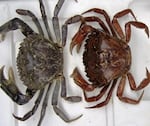New state regulations now allow recreational crabbers to catch triple the number of invasive green crabs from Oregon’s bays and inlets.

Green crab seen on the left. OFW advises anyone going out crabbing should take a good look at a picture of a green crab so they'll be able to identify them before harvesting.
Courtesy of Oregon Department Of Fish And Wildlife
The Oregon Fish and Wildlife Commission increased the bag limit of European green crab from 10 to 35 per day. It’s part of a concerted effort to eradicate these invasive crustaceans- which are known to compete with native crabs for food.
Green crabs themselves are fine to eat and some recipes even call for them. They are way smaller than Dungeness or even the red rock crab, making them harder to clean.
Mitch Vance is a Shellfish Project Leader with the Marine Resources Program at Oregon Fish and Wildlife. He wants people to know for certain it is a European green crab they are harvesting.
“Key characteristics that really help in the identification--five spines on each side of the crab and between the eyes there are three rounded bumps. It also has a very fan-shaped shell.”
Vance said green crabs cannot reproduce in cold temperatures, but since the ocean warming events of 2015, their numbers have dramatically increased.
Vance said the increased daily limit was also meant to give recreational crabbers a break. He said while folks were fishing for Dungeness when the limit was ten, if they unintentionally hauled in 11 green crabs as bycatch, they were in violation of the bag limit. And because the green crab is on the controlled species list, it was illegal to return the 11th green crab to the water. The new regulation addresses that conundrum.
Vance reminded that green crabs aren’t always green when they come out of the water. And juvenile Dungeness and native shore crabs can look a lot like green crabs in the rocky intertidal. He encourages crabbers should take a good look at a picture of green crabs before going out to harvest them.